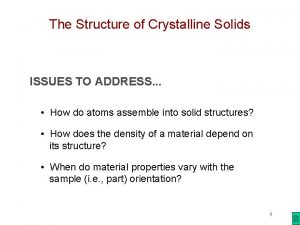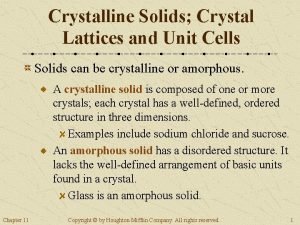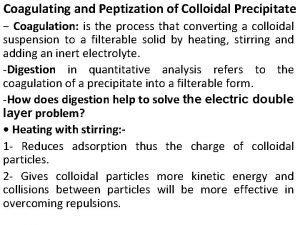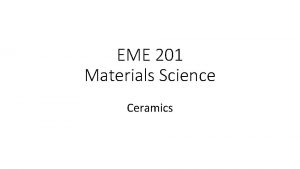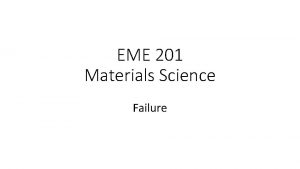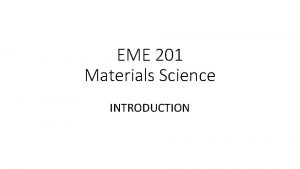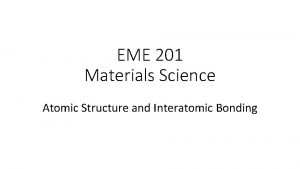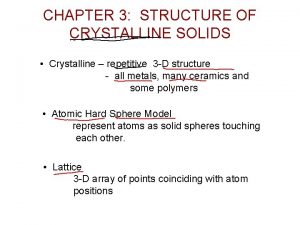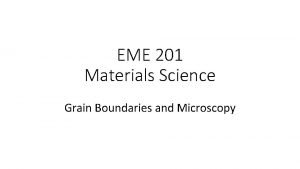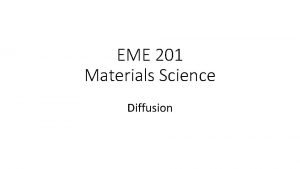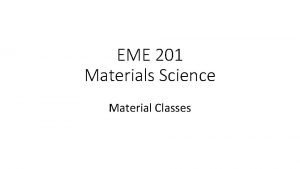EME 201 Materials Science The Structure of Crystalline











- Slides: 11

EME 201 Materials Science The Structure of Crystalline Solids

Short-Range Order versus Long-Range Order Figure 1. (a) Inert gases, (b, c) some materials with short-range order, (d) regular ordering of atoms/ions that extends through the material.

Short-Range Order versus Long-Range Order No Order: • In monoatomic gases like argon (Ar), atoms do not have regular order. • These materials randomly fill the available space everywhere Short-Range Order (SRO): • A material shows short-range order (SRO) if the unique arrangement of the atoms extends simplest to the atom’s nearest neighbors. • As an example, each water molecule in steam has a short-range order because of the covalent bonds among the hydrogen and oxygen atoms; that is, every oxygen atom is joined to 2 hydrogen atoms, forming an angle of 104. 5° among the bonds.

Short-Range Order versus Long-Range Order • A comparable state of affairs exists in materials referred to as inorganic glasses (the tetrahedral structure in silica). • 4 oxygen ions be bonded to every silicon ion. • But, beyond the basic unit of a (Si. O 4) four- tetrahedron, there is no periodicity within the manner those tetrahedra are connected. • In evaluation, in quartz or different sorts of crystalline silica, the silicate (Si. O 4)4 tetrahedra are certainly linked in specific periodic arrangements. • Many polymeric materials such as poly(methyl methacrylate) also illustrate short -range atomic arrangements that carefully resemble the silicate glass structure.

Short-Range Order versus Long-Range Order (LRO): • Most metals and their alloys, semiconducting materials, ceramics, and some polymeric materials have a crystal structure that shows the long range order (LRO) arrangement of atoms or ions; The unique atomic arrangement extends to lerger than one hundred nm on a scale. • The atoms or ions in those materials shape a three-dimensional regular repeating sample. • We confer with these materials as crystalline materials. • If a crystalline material contains only one crystal, we are referring to it as a sinle crystal material. • Single crystal substances are beneficial in many optical and electronic applications.

Short-Range Order versus Long-Range Order • The polycrystalline material contains many single crystals with various orientations in the space. • These single crystals in a polycrystalline material are known as grain structure. • A polycrystalline material resembles a collage of several small single crystals. • Borders between tiny crystals, in which single crystals are misaligned and known as grain boundaries. • Many crystalline materials that we are dealing with in commercial and engineering applications are polycrystalline. • Many properties of polycrystalline materials depend on both the physical and chemical properties of both the particles and the boundaries of the particles.

Amorphous Materials: Principles and Technological Applications • Any material displaying only short-range atom or ion is an amorphous material; that is, it is a non-crystalline material. • Generally, most materials want to make periodic adjustments because this configuration maximizes thermodynamic stability of the material. • Amorphous materials occur when the material does not allow the formation of kinetic periodic arrangements. • Most of polymeric materials are amorphous. • These materials contain small amounts of crystalline structure. • During processing, chains of relatively large polymer molecules travel to each other, resulting in entanglement. • The entangled polymer chaing do not crystallize themselves.

Amorphous Materials: Principles and Technological Applications Figure 2. Atomic arrangements in crystalline and amorphous silicon

Crystal Structures • Solid materials may be classified according to the regularity with which atoms or ions are arranged with respect to one another. • A crystalline material is one in which the atoms are situated in a repeating or periodic array over large atomic distances that is, long-range order exists, such that upon solidification, the atoms will position themselves in a repetitive threedimensional pattern, in which each atom is bonded to its nearest neighbor atoms. • All metals, many ceramic materials, and certain polymers form crystalline structures under normal solidification conditions. • For those that do not crystallize, this long-range atomic order is absent.

Crystal Structures • Certain characteristics of crystalline solids depend on the crystal structure of the material, the spatial arrangement of atoms, ions or molecules. • There are many different crystal structures, all of which are long-range atomic crystals; ranging from relatively simple structures for metals to highly complex structures. • When crystal structures are disclosed, atoms (or ions) are thought to be solid spheres with well-defined diameters. • In the atomic hard-sphere model, all atoms are the same. • The term lattice, which refers to a series of three-dimensional arrays overlapping with atomic positions, is sometimes used in the context of crystal structures.

REFERENCES • William D. Callister, ‘Materials Science and Engineering: An Introduction’, Seventh edition, John Wiley & Sons, Inc. , U. S. A. • Brian S. Mitchell, ‘AN INTRODUCTION TO MATERIALS ENGINEERING AND SCIENCE FOR CHEMICAL AND MATERIALS ENGINEERS’, John Wiley & Sons, Inc. , U. S. A, 2004. • J. W. Martin, ‘Materials for Engineering’, Third Edition, WOODHEAD PUBLISHING LIMITED, Cambridge, England. • Donald R. Askeland & Pradeep P. Fulay, ‘Essentials of Materials Science and Engineering’, Second Edition, Cengage Learning, Toronto, Canada. • G. S. Brady, H. R. Clauser, J. A. Vaccari, ‘Materials Handbook’, Fifteenth Edition, Mc. Graw-Hill Handbooks.
 Atom and its structure
Atom and its structure Lattice basis
Lattice basis Crystalline solid and amorphous solid
Crystalline solid and amorphous solid Is cotton candy anisotropic
Is cotton candy anisotropic Crystalline solid
Crystalline solid Crystalline substances
Crystalline substances Crystalline candy
Crystalline candy Crystalline solid
Crystalline solid Coprecipitation errors
Coprecipitation errors Difference between colloidal and crystalline precipitate
Difference between colloidal and crystalline precipitate Difference between colloidal and crystalline precipitate
Difference between colloidal and crystalline precipitate Difference between colloidal and crystalline precipitate
Difference between colloidal and crystalline precipitate
